
8 minute read
Petals of the Champaka: The life and culinary legacy of Than Phu Ying Kleeb Mahidorn
This is a free read from Ghost Dance issue 01. To unlock full access to all content, please purchase the magazine for £8.00 / €9.00 / $11.00.
Petals of the Champaka: The life and culinary legacy of Than Phu Ying Kleeb Mahidorn
Advertisement
Words by Rosalind Yunibandhu
With the sun glowing orange just above the horizon, and the gentle ripples of the Chao Phraya river lapping against the side of his rowboat, a warm breeze rustled the folds of La-Or’s saffron robes as he began to paddle north, in his characteristic, measured way. Some distance upriver, amidst the verdant orchards of Bang Yi Khan, Kleeb Jumpa waited patiently to offer the morning’s alms: freshly steamed rice and a selection of her special home recipes. But for the occasional, melodic calls of turtle doves - and an inexplicable flutter in her heart – the morning was still and calm. Little did she know she would not only shortly be gazing into the eyes of her future husband – but also that, while he would become one of the most powerful men in the Kingdom – she would be remembered for her culinary legacy for centuries to come.
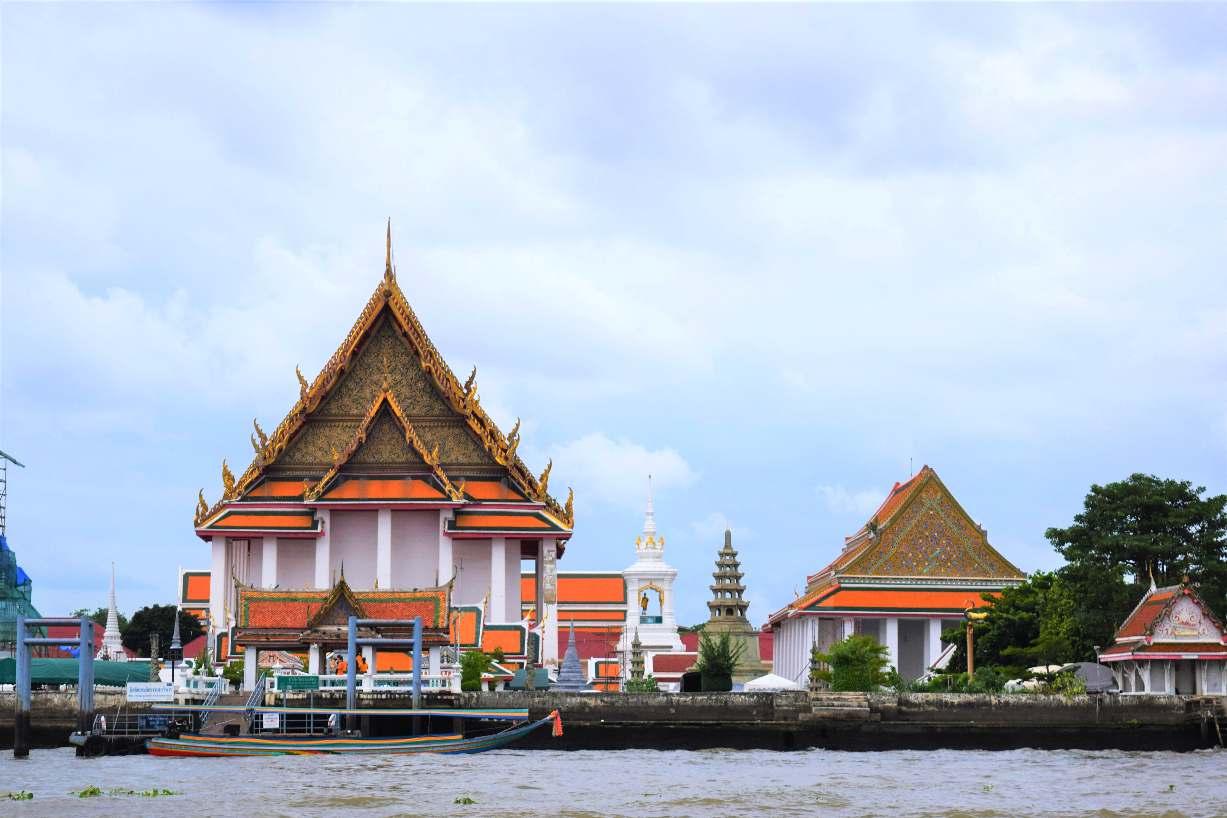
La-Or Krairiksh was my great-grandfather, and this is how (or, at least, based on family stories, how I imagine) he met my great-grandmother, Kleeb Jumpa, that fateful morning in late 19th century Siam. From an esteemed Chinese family serving the Chakri Dynasty since the time of King Rama I, La-Or was a budding junior civil servant who’d just ordained as a monk for a short time, as was customary for young men. Holding the honour of being the first-ever law graduate of Siam, over the years, he would eventually rise through the ranks to become Lord Chamberlain of Siam during the reigns of Kings Rama VI and VII - the highest-ranking civilian after the King himself.
Kleeb Jumpa (‘Petal(s) of the Champaka’) was the daughter of a Laotian aristocrat descended from Chao Anuwongse - the last King of Vientiane – and a local Siamese orchard grower. Despite first encountering her future husband in the riverine community of Bang Yi Khan, she had, in fact, been raised from the age of 7 in the inner courts of the Royal Palace by her aunt, a consort to King Rama IV. She’d very nearly become a consort herself: during her teenage years, her father had politely declined an offer to present her to King Rama V, and sent her to instead live in the orchards for 3 years.
Thus, it was in the Palace that TPYK learned the foundations of palace cuisine, under the care and guidance of her aunt and the court ladies. She also developed a particular fondness and talent for traditional floral arts.
It was during her time at the orchard in her late teens, however, that she had a chance to truly connect to nature and its bounty. At Bang Yi Khan, she learned from the orchard-growing side of her family how to cultivate, harvest and preserve fruits and vegetables – which, no doubt, allowed her to understand even more deeply how the land, cultivation and processing techniques impacted the flavours she brought to the table. She also even dabbled in trade, drying and cutting banana leaves for the maids to sell in the local markets – thus inadvertently developing a complete view of the 19th century Siamese food system.
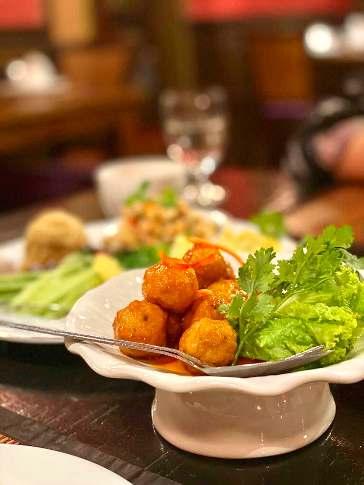
Tod Mun Goong (savoury prawn balls in prawn fat)
While there were most certainly other royal and noble ladies gaining recognition for their culinary skills during this period, TPYK stood out in her mastery and fusion of varied cuisines; indeed, her food, in a sense, mirrored the confluence of cultures taking place in broader society at the time - as old Siam evolved into modern Thailand.
TPYK’s later marriage to CPM further broadened her repertoire of Western cuisine. As wife to an important personage, many occasions required her to entertain or be entertained by, foreign dignitaries (as well as satisfy her husband’s particular passion for Western food). She was also introduced to Krairiksh family Chinese recipes, handed down through the generations, including gaeng hong, or stewed pork and bamboo – and never forgot her own Laotian heritage either, frequently rustling up dishes like yum salad wiengchan, a Vientiane-style bamboo salad.
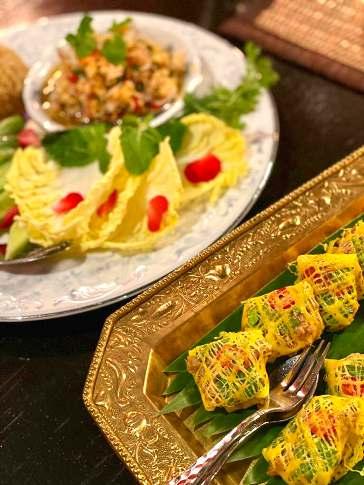
Roum (herbed meats wrapped in delicate 'golden' egg threads)
Photo supplied by Rosalind Yunibandhu
In time, TPYK became renowned for her food in upper circles. But, she soon noticed that times were changing. In the post-war period, household structures were transforming: even in noble circles, large retinues of servants were no longer economically sustainable; this, in turn, meant that the preparation of intricate and labour-intensive palace-inspired dishes was becoming rarer. Worryingly, traditional recipes were beginning to be forgotten.
With this in mind, as she approached her 7th cycle (72nd birthday) in 1949, TPYK decided to record her recipes for her children, grandchildren and future generations – dictating to her niece over 100 of her personal recipes, from canapes and appetizers to soups and salads, curries, fish and meat dishes, and desserts. Her foreword to the 1949 edition of her now-legendary cookbook, ‘Recipes to Teach my Children and Grandchildren [Descendants]’ reads:
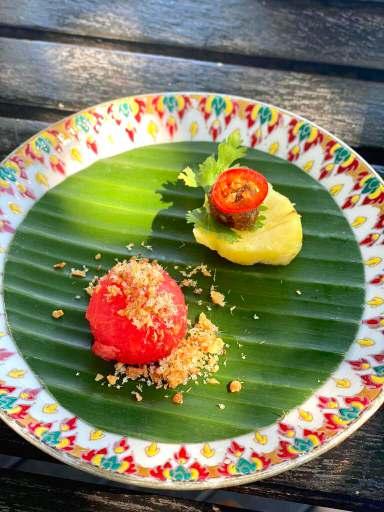
Mah Haw (spiced pork canapés on pineapple and watermelon)
Photo supplied by Rosalind Yunibandhu
The book was once again published as part of her funeral memorial book upon her passing in 1961, and also later featured in that of her household’s trusted valet, Mr. Sian Kamnerdkarn in 1982. A 4th edition was published on the occasion of the wedding of her great-granddaughter Ms. Mitraporn Krairiksh, in 2007.
In 2011, Dr. Piriya Krairiksh, commissioned a project to reproduce the 5th edition of TPYK’s cookbook, led by my aunt, Dr. Kamontip Snidvongs, and supported by Khun Uba Kunjara, my parents, Dr. Kraipun and Mrs. Nisakorn Yunibandhu, and Mr. Alex Blackwood. This time, however, the recipes were enhanced with modern measurements based on original taste and provided in English too. Over the course of 3 months, each recipe was rigorously taste-tested by family members who’d had direct experience of TYPK’s cooking: my then 93-year-old great-aunt, Mrs. Chairak Snidvongs, and my father – who’d been personally raised by TPYK and CPM between the ages of seven and fifteen.
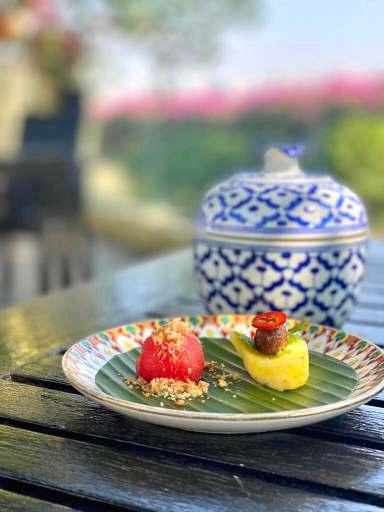
Mah Haw (spiced pork canapé on pineapple) alongside Phat Bplaa Haaeng Dtaaeng, a popular palace appetizer (fried dried fish on watermelon)
Photo supplied by Rosalind Yunibandhu
Whilst originally intended as a didactic book for her direct family, since its release into the public sphere as part of her funeral memorial book, both the original and modern editions have become somewhat cult classics amongst both Thai and foreign chefs and foodies interested in historical Thai cuisine. Even today, in 2021- over 70 years since its first publication - we can still find recipes from her cookbook interpreted in restaurants across Bangkok. (Whether or not the interpretations are accurate, however, only my father and other family elders can say!)
While, unbeknownst to myself, I’d actually enjoyed many of TPYK’s recipes growing up (such as gaeng jee juan, or ‘three-flavours’ chicken curry, and pad pakkad khem, or stir-fried pickled radish), for most of my life, I’d had no idea of the true significance of my great-grandmother’s contribution to Siamese culinary heritage. I only really came to ‘know’ her towards the end of last year, as we began our latest family project to bring the sixth edition of TPYK’s cookbook to the wider public.
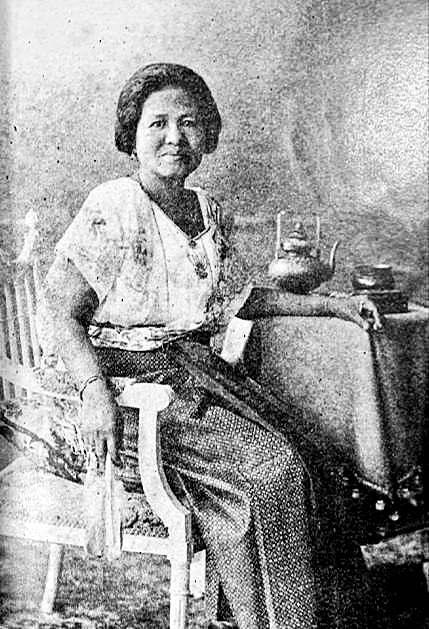
Than Phu Ying Kleeb Mahidorn
Photo supplied by Rosalind Yunibandhu
During the specific moment at which I realized this significance, I was balancing a Siamese palace canapé, mah haw, between my fingers in one hand, and comparing it with an image in the 2011 edition of the cookbook I held in my other hand. It was a remarkably accurate interpretation. I was at Praya Palazzo - a beautifully-restored, early 1930s, Palladio-style mansion-turned-luxury-boutique-hotel. With an impressive and touching vision to honour Thai culinary heritage, Praya Dining, its Michelin Plate-awarded restaurant, explores historical Thai cuisine from the Sukhothai and Ayutthaya periods, right through to the reign of Rama 7. Included in its repertoire are selected recipes from TPYK’s cookbook.
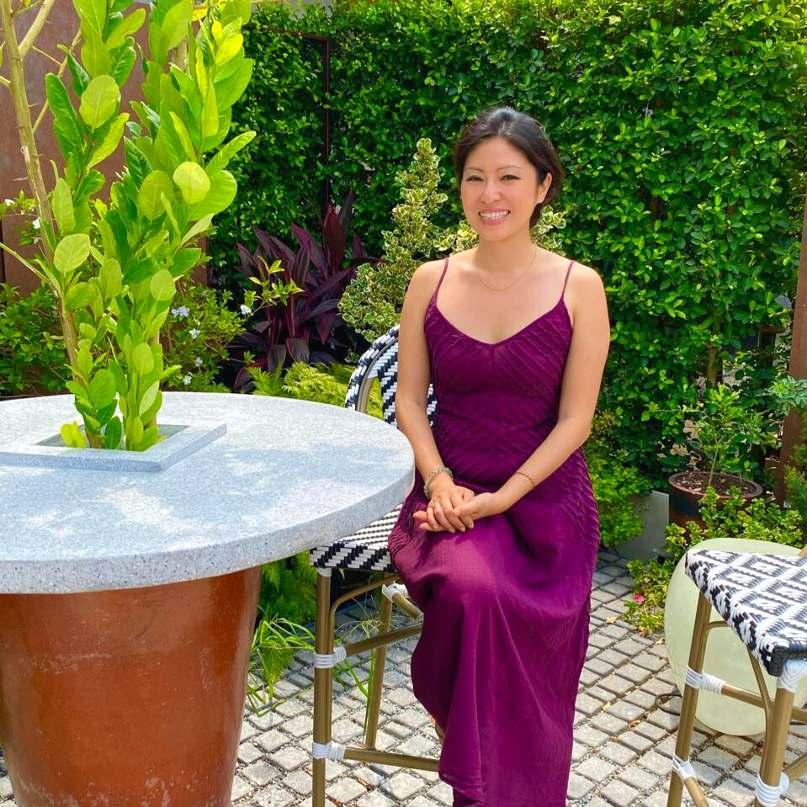
Rosalind Yunibandhu
As I placed the mah haw in my mouth, I was concomitantly flooded with emotion and flavour. Here I was, perhaps over a century since TPYK would have made her first mah haw . In that one bite, I could feel not just my great-grandmother’s spirit, but also that of the generations of women (and, perhaps, some men) before and after her, who’d passed their culinary wisdom to and from her – allowing this delicious morsel to be delivered to me, on this plate, on this particular day. The tart but sweet juiciness of the pineapple, the savoury umami of the garlic-infused pork, the fragrance of fresh coriander root – all presented on elegant period ceramics - was more than an eating experience for me: it was a communion.
As I work together with my cousins on the sixth edition of TPYK’s recipe book, I begin to feel the profound honour it is for us to do this work, as the direct ‘descendants’ to which the original volume was addressed. But, we don’t want this next edition to be a ‘just’ a family recipe book. We also want to be able to share the, to date, untold, stories that will help us to better understand her and her food; the personal and cultural context in which she developed her recipes, that can only come from the elder storytellers of our family. In the end, to us, TPYK’s recipes are far more than just simple dishes; they are a window onto the life and times of a remarkable Siamese woman, living in a unique time and place – and a great legacy for generations of all Thai people to come.
Rosalind Yunibandhu is the Founder and Managing Director of Arcadia Fine Foods, a company whose mission is to restore our harmony with nature through food and food experiences. She believes that food offers us more than just sustenance and can be used as a vehicle through which we can share knowledge and wisdom. She holds degrees from Cambridge and Oxford Universities. You can follow her on Instagram at @arcadiafinefoods







